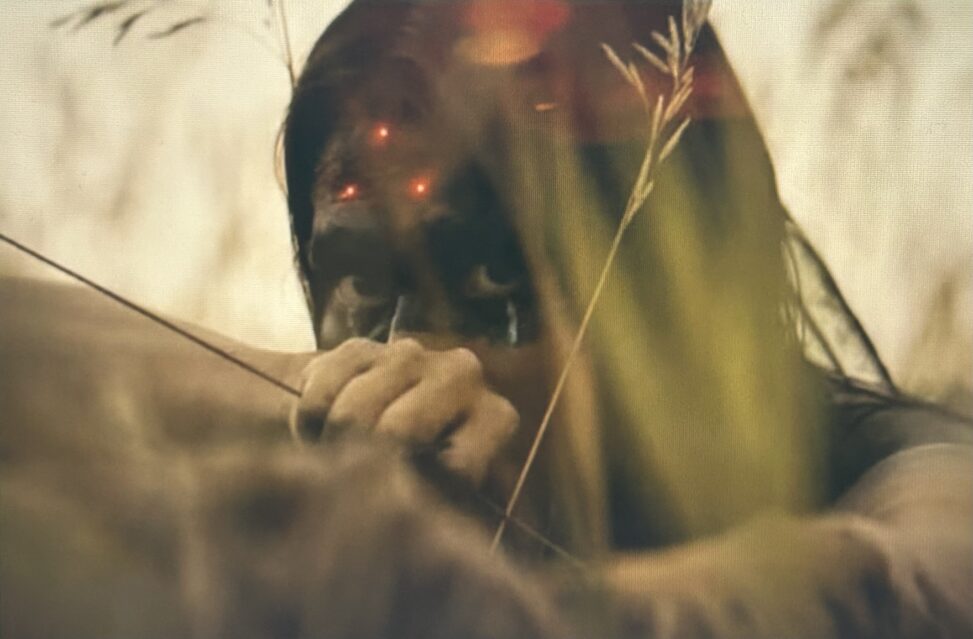Assignment 1, Part 1
The film Prey (2022), directed by Dan Trachtenberg, follows a young Comanche woman named Naru. She is persistent on becoming a hunter and challenging traditional gender norms. Hunting is well represented in the film when Naru and her tribe hunt for survival, they respect and use hunting ethically. Meanwhile, the Predator hunts because it can, it wants to control nature and assert dominance. The Fur Trappers use hunting solely for profit, they exploit animals and don’t show respect. In the scene, (0:53:30 – 0:53:50), Naru is hiding in the tall grass from the predator. The scene starts with the camera facing Naru and a boy from her tribe. Then it changes to the Predator’s view, slowly moving through the tall grass at an eye level angle, camera uses a dolly forward through the grass. This gives it a suspenseful view from the Predators POV.
The Predator embodies masculinity with its violent, dominating appearance and actions. The Fur Trappers wanted to dominate all animals and people, they showed arrogance and selfishness. The Comanche Warriors are skilled and work as a community. In the scene, (0:59:27 – 0:59:45) Naru and her brother are used as bait by the Fur Trappers to lure in the Predator. The camera is facing the ground and moves forward, turning toward Naru and her brother. The camera POV changes to a high view of the forest they’re in. The camera slowly uses a dolly going backwards revealing two of the fur trappers, waiting for the predator to strike.
Prey challenges the long-established “hard body” action hero model. In this film, Naru is a strong young woman who uses her intellect, skill, and resourcefulness to become an outstanding hunter. In the first Predator, the “hardbody” action hero is played by Arnold Schwarzenegger. He is dominating, from his physical strength, to his power of masculinity shown within his character. Naru’s character challenges this “hardbody” action hero model by not needing physical strength or dominance to hold such power when hunting.
The comparison between the Predator and the Fur Trappers is that they both have advanced technology and neither of them respect their hunt. The Predator uses its alien weapons to brutally slash its prey, while the Fur Trappers have tools like rifles, traps, etc. Neither the Fur Trappers or the Predator have respect for what they are hunting and do it to feel powerful. The predator trophy hunts, he doesn’t care about ecological stability and neither do the Fur Trappers. In the scene, (0:13:45 – 0:13:53) the camera shows a mouse in the grass, it’s a low angle showing that the mouse is weak. The camera uses a slow pan around the mouse, the focus then changes to a snake sitting across from it. The snake snaps to eat the mouse, the view changes to an extreme close up on the snake. Soon after the Predator grabs the snake and kills it quickly. Showing that he will remove anything that gets in his way.
Naru’s character challenges action hero archetypes. She uses her cleverness to take down the Predator. Naru is expected to take on medicine, not hunting, she overcomes this stereotype by her determination to fight. Her character is constructed differently compared to indigenous representations in Hollywood. The film focuses on Naru’s resourcefulness and resistance. It shows her leadership skills. She doesn’t just fight with weapons, she fights with her emotional intelligence. It starts to fall into western action stereotypes by embodying the lone hero trope. Naru leaves to find the Predator, alone, and she finishes the fight alone. Naru’s empowerment is real although it can fall into some familiar movie tropes. Naru’s character is played and represented well, from her adaptability to her heroism portrayed in the film

Provide Feedback